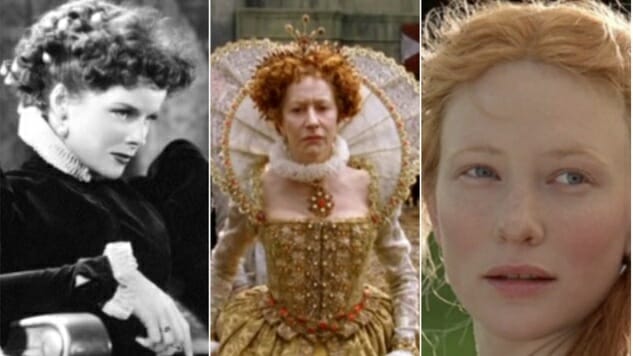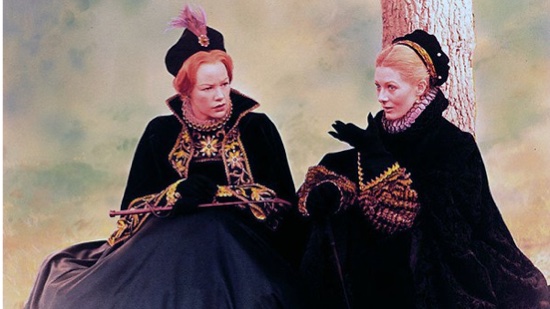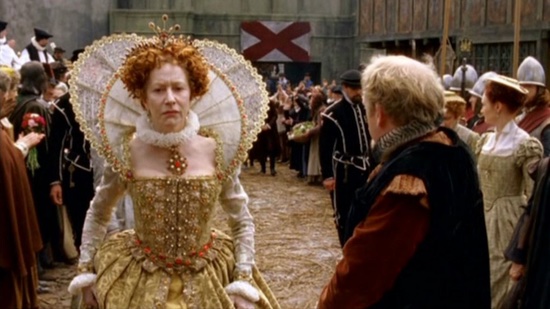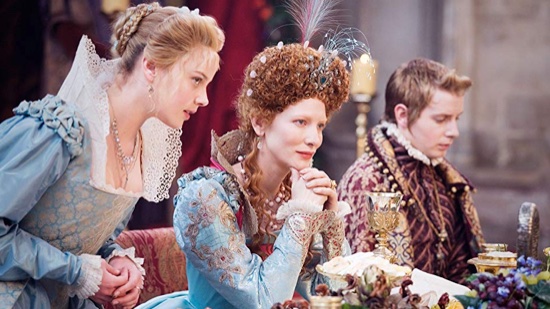5 Movies about the Queens to Go with (or in Place of) Mary Queen of Scots
Movies Lists Queen Elizabeth
Forget Bette Davis vs. Joan Crawford or Cardi B vs. Nicki Minaj, the OG celebrity feud is the two-decade one between Queen Elizabeth I and Mary Queen of Scots. This sprawling story is of course too large to explain in one sentence, but the gist of the tension derives from the difference in faith between the two queens, Elizabeth being a then-controversial Protestant, and Mary a more traditionally accepted Catholic. Mary threatening the “virgin queen” with an offspring who will one day rule England, and an assassination attempt on Elizabeth’s life being blamed on Mary complicated things further, culminating in a decision that will hang heavy on one ruler’s head, and the literal removal of the head of the other. Such a real-life story of intense palace intrigue full of conspiracies, lurid gossip, shrewd political moves, backstabbings—some metaphorical, some literal—has of course given birth to numerous fictionalized retellings through various media. With the recent release of yet another prestige costume drama about the British Isles’ most famous queenly tandem in the form of the Margot Robbie and Saoirse Ronan-starrer, Mary Queen of Scots, let’s look at five other movies about this rivalry (presented here in chronological order).
Mary of Scotland (1936)

Mary played by: Katherine Hepburn
Elizabeth played by: Florence Eldridge
This is the black-and-white, borderline soap opera-style stuffy old-fashioned costume drama one would expect from a 1936 production about Mary’s ascension as the beloved leader of the Scots. It showcases an uncharacteristically static and theatrical direction by John Ford, who became less and less fond of the project as the production carried on. Ford was understandably bored by the blank verse dialogue of the play the film was based on, and struggled to extract depth and passion not found in the play. He even let star Katherine Hepburn direct a scene as a way to experiment with tone. The result was not much more than a filmed play (actually a fine choice for audiences in search of a more Shakespearean and acting-oriented theatrical experience). It’s clear whose side the film is on, since Hepburn’s Mary is a red-blooded, passionate woman who takes no crap from anybody (i.e., Hepburn herself), and Florence Eldridge’s Elizabeth is portrayed as an old fuddy duddy who’s solely manipulated by the powerful men who surround her.
Mary, Queen of Scots (1971)

Mary played by: Vanessa Redgrave
Elizabeth played by: Glenda Jackson
This is a ’70s take on Mary’s story, so of course it comes fully equipped with the narrative tendencies that enveloped prestige costume dramas of the decade: That soft focus look with blown out whites and earthly tones, a naturalistic look that uses real life locations, and a deliberate pushing of the cultural envelope via some impressively grisly gore, as well as the sprinkling of a gay relationship at the center of the tale. With sadness and hope in her eyes, Redgrave portrays Mary as a tragic figure, a woman who merely wanted a happy family life while lording over her beloved Scotland, only to be inevitably dragged into a series of conspiracies and political chess moves beyond her control. As the events spiral toward her oblivion, Redgrave sticks to Mary’s strength of convictions and moral center. On the other hand, Glenda Jackson’s Elizabeth is a cold, shrewd and calculating political animal who sees everyone as pawns in her ploy for power. After Mary’s fateful end, this is the only adaptation of this story that shows Elizabeth without much guilt or regret, mourning her decision in a flat and emotionless way, as if going through the motions to show her people that she indeed is a member of the human race. If you’re a fan of Mary and hate Elizabeth, this is the flick for you.
Elizabeth (1998)

Elizabeth played by: Cate Blanchett
Mary played by: No one
Director Shekhar Kapur’s origin story of Elizabeth I was very well-received upon its release due to its fresh take on the royal period drama genre, putting heavier emphasis on a political thriller tone rather than a lighter soap opera that banked on the attractiveness of the costumes. Cate Blanchett’s star-making turn as Elizabeth, capturing every facet of her tremendous character arc from the naïve girl with the world’s troubles thrust upon her to the fearless leader she becomes after destroying an army of ambitious men with their eyes on the throne. The movie still holds up due to its universal themes that depict the political power struggles with a deft touch. As with all origin stories, Elizabeth ends with a sequel tease that introduces the upcoming villain. Just like Gary Oldman’s Jim Gordon showing the Joker card to Christian Bale’s Batman at the end of Batman Begins, Elizabeth is informed by Nick Fury (Samuel L. Jackson) that she shouldn’t be too comfortable after beating her enemies, since Mary, Queen of Scots is gaining power. (I made up the Nick Fury part, but how awesome would that have been?)
Elizabeth I (2005)

Mary played by: Barbara Flynn
Elizabeth played by: Helen Mirren
This HBO miniseries would be the right choice for the audience looking for a more comprehensive biopic about Elizabeth I, since the longer runtime allows for it to cover larger ground than a two-hour feature. It also sees the graphic violence in the 1971 Mary, Queen of Scots and proudly says, “Hold my beer.” We get multiple disembowelments and decapitations in glorious gory detail. As she does with pretty much every part, Mirren is transcendent as Elizabeth, extracting depth and detail previously unexamined. First of all, this is an Elizabeth who actually enjoys her power and showcases an indelible sense of humor and adventure. However, scorn her at your own peril, since her wrath more than matches her passionate love for her people. The focus of the miniseries is the on-again, off-again romance between Elizabeth and the Earl of Leicester (Jeremy Irons). As opposed to Cate Blanchett and Joseph Fiennes, who played the Earl in Elizabeth, Mirren and Irons have a palpable chemistry that creates the emotional anchor of the piece. Barbara Flynn’s Mary is depicted as more of a maternal figure than a fraternal one, her soft-spoken yet passive-aggressive demeanor piercing Elizabeth’s guilt regarding her own treatment of Mary. This is the only version of Mary in this list of films who speaks with a French accent instead of a Scottish one. Considering her upbringing in France, this actually makes more sense.
Elizabeth: The Golden Age (2007)

Mary played by: Samantha Morton
Elizabeth played by: Cate Blanchett
It’s hard to stomach that the same pairing of director Shekhar Kapur and star Cate Blanchett brought on this overwrought sequel to the refreshingly restrained Elizabeth. This follow-up about the Virgin Queen’s formative years is a giant chunk of cheese, a full-blown unapologetic melodrama that deifies Elizabeth as the badass, stoic, literally God-annointed ruler of her land, only to awkwardly switch gears into a soap opera love triangle, with her at the center as a blubbering emotional wreck because her bae (Sir Walter Raleigh, played by Clive Owen) is hooking up with a hotter and younger version of herself (Abby Cornish). Oh no he di’int! But even though the movie doesn’t work as intended, it is the one to check out if you’re looking for an unintentionally campy experience. In that sense, Elizabeth: The Golden Age provides smashing entertainment. As a reverse of the 1971 Mary, Queen of Scots, Samantha Morton’s Mary is the stoic and cold politician to Blanchett’s emotion-driven Elizabeth. (Morton manages to infuse more empathy and humanity into her character in comparison to Glenda Jackson’s performance.)